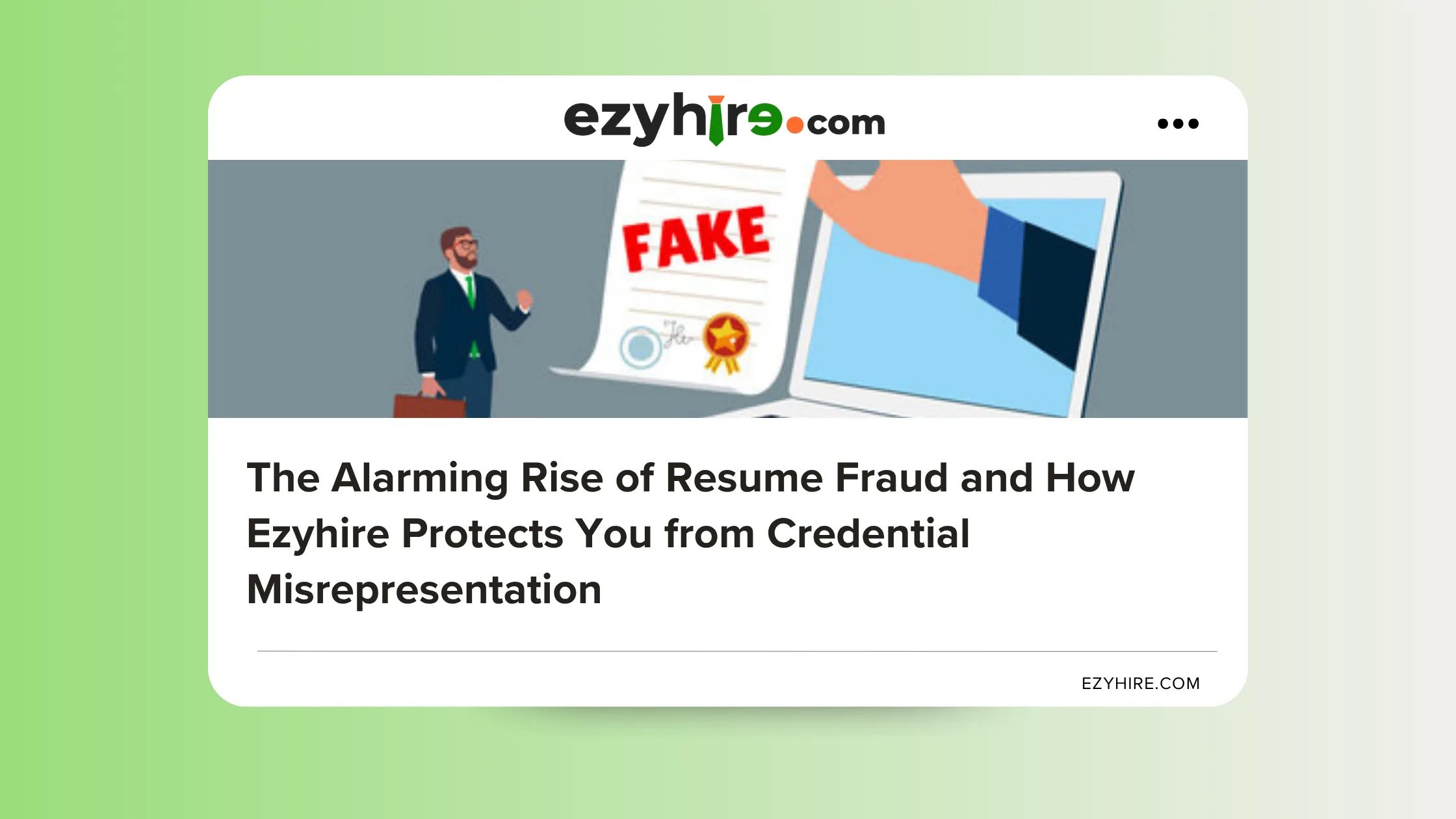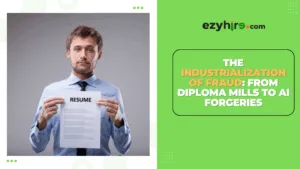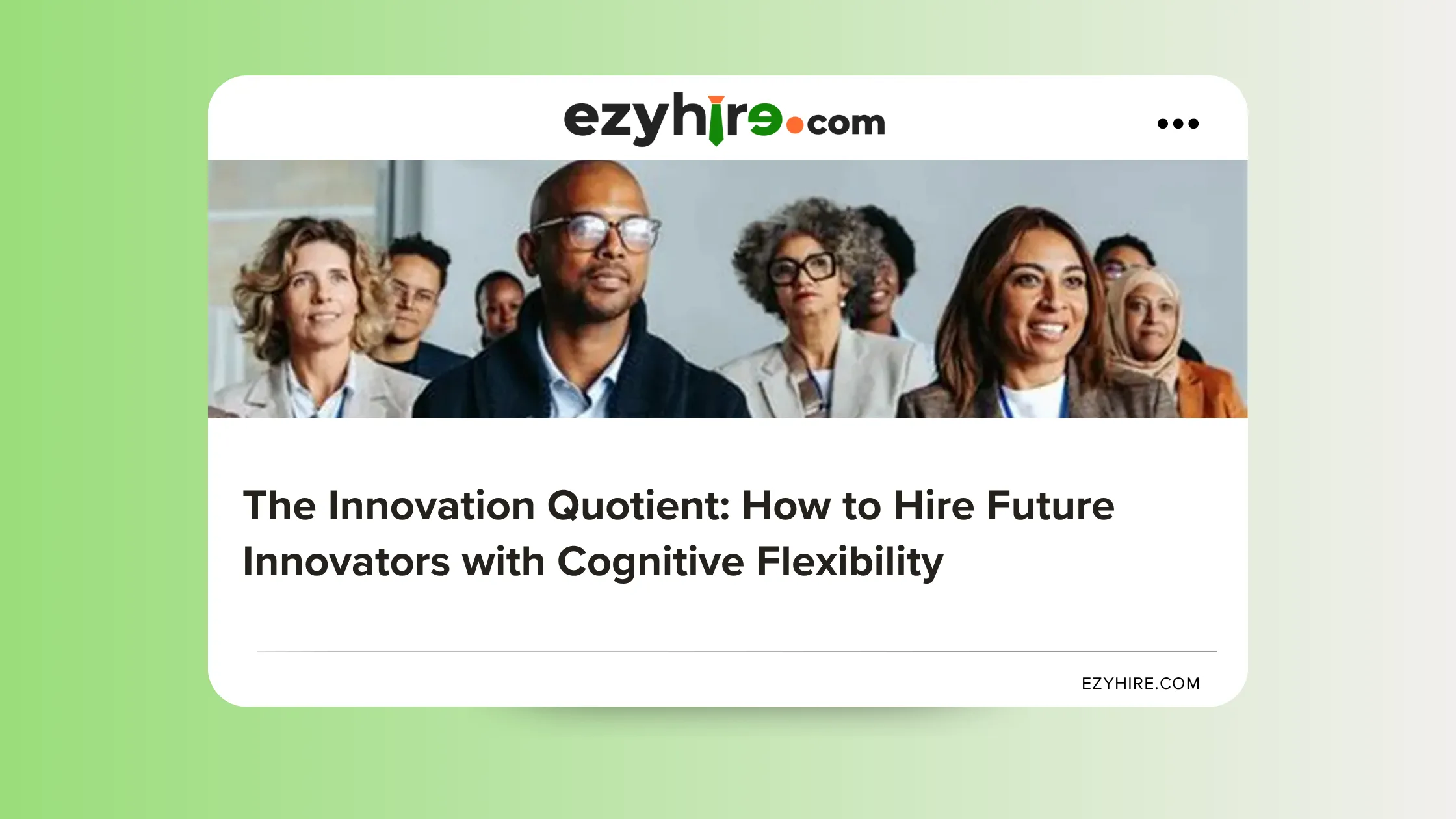Introduction: The Trust Deficit in Modern Hiring
Every successful hire begins with trust. Yet, in 2025, this foundation is crumbling under a growing epidemic: credential misrepresentation.
Recent studies reveal a startling truth: over 64% of professionals admit to lying on their resume, up sharply from 55% in 2022. This translates to more than 107 million deceptive resumes circulating in the U.S. workforce. The result is not just individual dishonesty but a systemic threat that costs the global economy an estimated $600 billion each year through lost productivity, fraud, and legal exposure.
The danger is no longer confined to small exaggerations. A sophisticated fraud ecosystem—fueled by generative AI, deepfakes, and global diploma mills—has industrialized deception. Employers are now facing applicants who can fabricate degrees, identities, and even live interview personas with chilling precision.
In this environment, traditional hiring methods cannot keep up. Paper-based verification and visual inspections are obsolete. This report exposes the modern anatomy of credential fraud, its devastating business costs, and how Ezyhire’s multi-layered verification system provides the only reliable defense against this silent epidemic.
The New Anatomy of a Lie: Deception in the Digital Age
Credential fraud has evolved from individual misrepresentation into a fully-fledged industry. To defend against it, employers must first understand how it operates.
The Statistical Reality of Resume Fraud
The data paints a sobering picture. Candidates most often lie about:
- Previous salary: 32.8%
- Skills: 30.8%
- Work experience: 30.5%
- College degree: 30%
Among those falsifying academic credentials, 54% fabricate degrees entirely, while others misrepresent their field of study or institution.
Younger job seekers are leading this deception wave. Over 80% of applicants aged 18–25 admit to lying on their resumes, driven by financial pressure and job market competitiveness.
The problem is compounded by success rates that reward dishonesty:
- 63% of applicants who lie receive job offers.
- 96% are never caught.
- 73% say they would lie again.
This dangerous cycle normalizes deceit as a low-risk, high-reward tactic—creating a trust crisis at the very heart of modern hiring.
The Industrialization of Fraud: From Diploma Mills to AI Forgeries
Today, resume fraud is an organized global industry. Over 1,000 diploma mills operate in the U.S. alone, producing fake degrees for as little as $183. These counterfeit institutions often have fabricated accreditation bodies and realistic websites that mimic legitimate universities.
Generative AI has amplified this deception. In seconds, anyone can create:
- AI-generated fake certificates with convincing logos and signatures.
- Deepfake photos and videos that impersonate real candidates during video interviews.
Nearly three-quarters (73%) of job seekers say they would use AI to help lie on their resume. With such tools easily accessible, fake credentials and identities have become virtually indistinguishable from real ones.
This convergence of technology and deceit has created a crisis of verifiability. Employers can no longer rely on what they see or hear in interviews. Authenticating identity and credentials must now happen at the source, using advanced technology that can detect manipulation and confirm truth in real time.
The Domino Effect: Calculating the True Cost of a Deceptive Hire
Hiring a fraudulent candidate triggers a cascade of financial, legal, and reputational damage. The consequences go far beyond one bad hire.
The Financial Black Hole
A single deceptive hire can cost a company up to $240,000 in direct expenses, including recruitment, salary, and eventual replacement. The U.S. Department of Labor estimates the loss at 30% of the employee’s first-year earnings, even before considering hidden costs.
Indirect losses multiply rapidly:
- Productivity declines as other employees compensate for underqualified hires.
- Occupational fraud costs companies an average of $145,000 per incident, and up to $500,000 when committed by executives.
- Security breaches from unqualified or unethical hires can cost millions in data loss, fines, and customer trust.
The Legal Minefield of Negligent Hiring
Under the doctrine of negligent hiring, employers can be held legally responsible for damages caused by unfit employees—especially if proper verification could have prevented the harm.
The financial fallout can be catastrophic:
- Average settlement: $1 million
- Highest recorded verdicts: Over $26 million
- Largest judgment: $1 billion against a U.S. trucking company
Real-world cases underline the danger. In the UK, Zholia Alemi worked as a psychiatrist for 20 years with a forged medical degree, earning over £1 million before being caught. Her fraudulent practice endangered patients and exposed systemic verification failures.
These examples reveal the enormous legal and moral responsibility employers bear. A single oversight in due diligence can become a multimillion-dollar liability.
The Cultural and Reputational Fallout
The damage from resume fraud also runs deep within company culture. Once a fraudulent employee is exposed, internal trust collapses. Teams lose confidence in leadership, morale declines, and top performers may leave.
Externally, public scandals erode brand reputation and make talent acquisition more difficult. Research shows that companies with damaged reputations pay at least 10% more per hire to attract candidates.
Ignoring verification is not just a financial risk, it’s an existential one.
Your Only Defense: A Multi-Layered Verification Strategy with Ezyhire
In an era of synthetic resumes and AI-powered deception, Ezyhire provides the only scalable, technology-driven defense that verifies identity and credentials with unmatched accuracy.
Layer 1: Authenticating the Individual with Ezyhire PhotoID Verification
The first layer of protection begins with identity authentication. Before verifying credentials, you must confirm the candidate is who they claim to be.
Ezyhire PhotoID Verification uses AI facial recognition to match a live video capture of the candidate with their government-issued ID.
Key features include:
- Passive Liveness Detection: Detects whether a candidate is presenting a real face or a screen-based or printed photo.
- Screen ID and Paper ID Liveness: Prevents spoofing attempts by identifying fake ID displays or altered printouts.
- Tamper and Fake ID Detection: Automated checks flag document forgery, manipulation, or AI-generated IDs.
- Global Reach: Supports verification for IDs from over 130 countries.
This ensures only legitimate, live candidates move forward, eliminating impersonation and deepfake risks from the hiring funnel.
Layer 2: Validating the Credentials with Ezyhire Background Verification (BGV)
Once identity is confirmed, Ezyhire’s Background Verification (BGV) process validates all academic and professional claims at the source.
Education Verification:
Ezyhire contacts universities and colleges directly to confirm attendance, degree type, and graduation date—bypassing potentially forged documents entirely.
Employment Verification:
Through direct communication with previous employers’ HR departments, Ezyhire validates job titles, employment dates, and responsibilities, revealing inflated or falsified work histories.
Additional Risk Checks:
Ezyhire conducts national criminal record searches, sex offender registry scans, and global watchlist checks, providing a 360-degree risk profile that protects employers from negligent hiring liability.
| Threat Vector | Description | Ezyhire’s Countermeasure |
| Identity Fraud & Deepfakes | AI-generated personas or stolen identities used in remote interviews | PhotoID Verification with AI facial recognition and liveness detection |
| Fake Degrees & Certifications | Fraudulent documents from diploma mills or forged legitimate credentials | Direct education verification with global academic institutions |
| Falsified Work History | Fabricated job titles, timelines, and achievements | Employment verification through verified HR contacts |
| Global Applicant Deception | Cross-border fraud using international fake credentials | Verification network covering 130+ countries with unified global compliance |
From Reactive to Proactive: Building a Culture of Verified Trust
The era of manual trust is over. In a world where AI can fabricate identities and degrees in seconds, proactive verification is not optional, it’s essential.
Ezyhire’s unified verification system transforms the hiring process from a reactive administrative task into a strategic compliance and risk management function. By integrating directly with Applicant Tracking Systems (ATS), Ezyhire embeds security into the heart of your recruitment workflow.
The Strategic Benefits of Ezyhire Verification
- Protect your brand: Prevent legal, financial, and reputational crises before they occur.
- Ensure compliance: Meet global hiring and data verification standards.
- Reduce risk exposure: Eliminate negligent hiring liability through documented due diligence.
- Improve hiring speed: Automate verification without compromising accuracy.
Verification is no longer just a cost—it’s an investment in organizational integrity, operational security, and long-term trust.
Conclusion: Reinforcing the Foundation of Trust
The rise of AI-generated fraud, fake degrees, and deepfake identities has redefined the boundaries of deception. Employers who fail to adapt are leaving themselves exposed to catastrophic losses.
Ezyhire’s multi-layered verification ecosystem offers a proven, scalable defense that restores trust to hiring by combining identity authentication, credential validation, and global compliance.
Building a workforce of integrity begins with certainty. It’s time to stop guessing—and start verifying.




